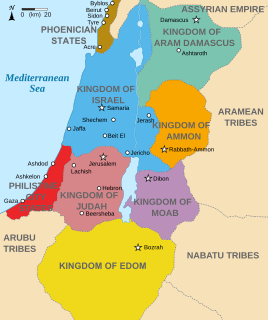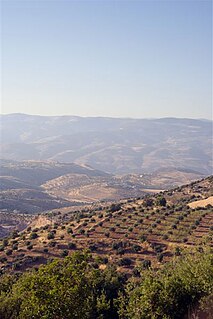Anakim were described as a race of giants, descended from Anak, according to the Old Testament. They were said to have lived in the southern part of the land of Canaan, near Hebron. According to Genesis 14:5-6 they inhabited the region later known as Edom and Moab in the days of Abraham. Their name may come from a Hebrew root meaning "necklace" or "neck-chain".

Moab is the name of an ancient kingdom that is today located in the modern state of Jordan. The land is mountainous and lies alongside much of the eastern shore of the Dead Sea. The existence of the Kingdom of Moab is attested to by numerous archaeological findings, most notably the Mesha Stele, which describes the Moabite victory over an unnamed son of King Omri of Israel. The Moabite capital was Dibon. According to the Hebrew Bible, Moab was often in conflict with its Israelite neighbours to the west.

Balak was a king of Moab described in the Book of Numbers in the Hebrew Bible, where his dealings with the prophet Balaam are recounted. Balak tried to engage Balaam for the purpose of cursing the migrating Israelite community. On his journey to meet the princes of Moab, Balaam is stopped by an angel of the lord after beating his donkey. He tells the angel he will return home: "I have sinned, for I did not know that you stood against me on the road". The angel instructs Balaam to attend the meeting with the princes of Moab but to "say only what I tell you". According to Numbers 22:2, and Joshua 24:9, Balak was the son of Zippor.

Gilead or Gilad is the name of three people and two geographic places in the Bible. Gilead may mean 'hill of testimony'. If this is the case, it is likely derived from גלעד gal‛êd, which in turn comes from gal and ‛êd. There also exists an alternative theory that it means 'rocky region'. It is now within the Kingdom of Jordan.

Nabu is the ancient Mesopotamian patron god of literacy, the rational arts, scribes and wisdom.
Horonaim is a city in Moab, mentioned in two Hebrew Bible oracles against the nation of Moab: in the Book of Jeremiah, and in the Book of Isaiah,. In 2 Samuel, an addition from the Septuagint text is sometimes translated as Horonaim, although it possibly derives from as little as a preposition.
Aroer is a biblical town on the north bank of the River Arnon to the east of the Dead Sea, in present-day Jordan. The town was an ancient Moabite settlement, and is mentioned in the Bible.
The Book of the Wars of the Lord is one of several non-canonical books referenced in the Bible which have now been completely lost. It is mentioned in Numbers 21:14–15, which reads:
Dalmanutha or Dalmanoutha (δαλμανουθα) is the unknown destination of Jesus on the shores of the Sea of Gallilee after he fed the four thousand, as recorded in Mark's gospel. It is sometimes believed to be in the vicinity of Magdala, the alleged home town of Mary Magdalene, since the parallel passage in Matthew's gospel, Matthew 15:39, refers instead to "Magadan", which has been taken to be a variant form of "Magdala".
Bamoth-Baal was an elevated point in the land of Moab mentioned in the Hebrew Bible. It was allotted to the Tribe of Reuben, and included with a list of towns near Heshbon. It is probably identical with the Bamoth between Nahaliel and the "valley that is in the country of Moab, to the top of Pisgah", mentioned in the list of stopping-places in Numbers 21:19-20. Bethbamot in the Moabite Stone, line 27, may also be considered as connected with it.

Matthew 12 is the twelfth chapter in the Gospel of Matthew in the New Testament section of the Christian Bible. It continues the narrative about Jesus' ministry in Galilee.
In the Hebrew Bible, as well as non-Jewish ancient texts from the region, the Northwest Semitic term Rephaite refers either to a people group of greater-than-average height and stature, or to dead ancestors who are residents of the Underworld. But among the devout in Judaism and Christianity, "Repha'im" or "Rephaite" is just a word to mean, "shades," or "spirits" known in the afterlife called, "Sheol."
Kirjath-huzoth or Qiryath Chutsoth, meaning city of streets or, city of villages, Numbers 22:39, was a Moabite city which some identify with Kirjathaim in eastern Jordan.
Kir of Moab is mentioned in the Hebrew Bible as one of the two main strongholds of Moab, the other being Ar. It is probably the same as the city called Kir-haresh, Kir-hareseth, and Kir-heres. The word Kir alludes to a wall or fortress. It is identified with the later city Al Karak.

Alcoholic beverages appear in the Hebrew Bible, after Noah planted a vineyard and became inebriated. In the New Testament, Jesus miraculously made copious amounts of wine at the marriage at Cana. Wine is the most common alcoholic beverage mentioned in biblical literature, where it is a source of symbolism, and was an important part of daily life in biblical times. Additionally, the inhabitants of ancient Israel drank beer, and wines made from fruits other than grapes, and references to these appear in scripture.

Thou shalt not kill, You shall not murder or You shall not kill (KJV), is a moral imperative included as one of the Ten Commandments in the Torah.
Nimrim, in Moab, is mentioned twice in scripture in the Tanakh and Bible, in Isaiah 15:6 and in Jeremiah 48:34.
Isaiah 15 is the fifteenth chapter of the Book of Isaiah in the Hebrew Bible or the Old Testament of the Christian Bible. This book contains the prophecies attributed to the prophet Isaiah, and is a part of the Book of the Prophets. This chapter and the following chapter deal with the forthcoming history of Moab.
Isaiah 16 is the sixteenth chapter of the Book of Isaiah in the Hebrew Bible or the Old Testament of the Christian Bible. This book contains the prophecies attributed to the prophet Isaiah, and is a part of the Book of the Prophets. This chapter continues the proclamation concerning Moab commenced in the previous chapter.






